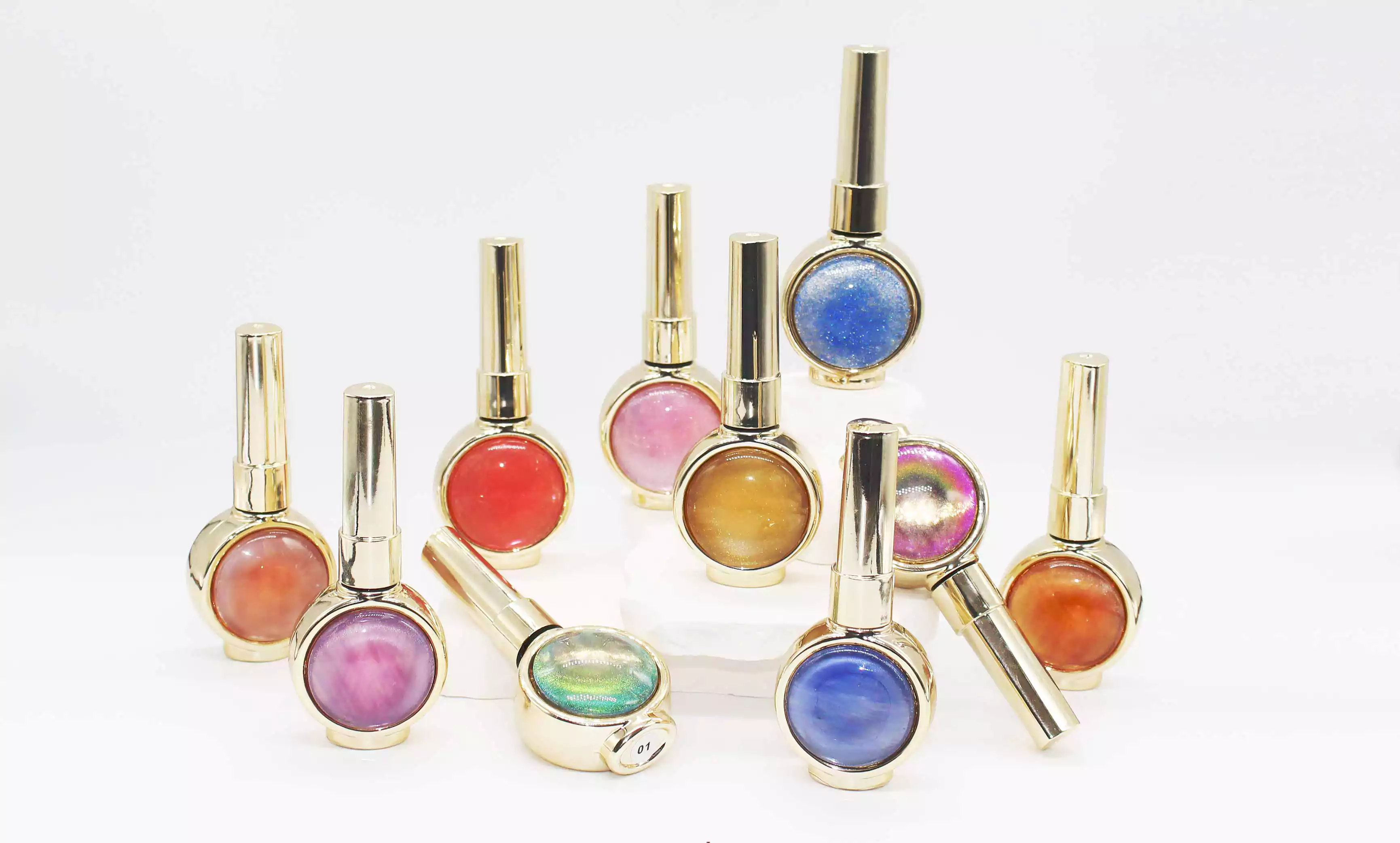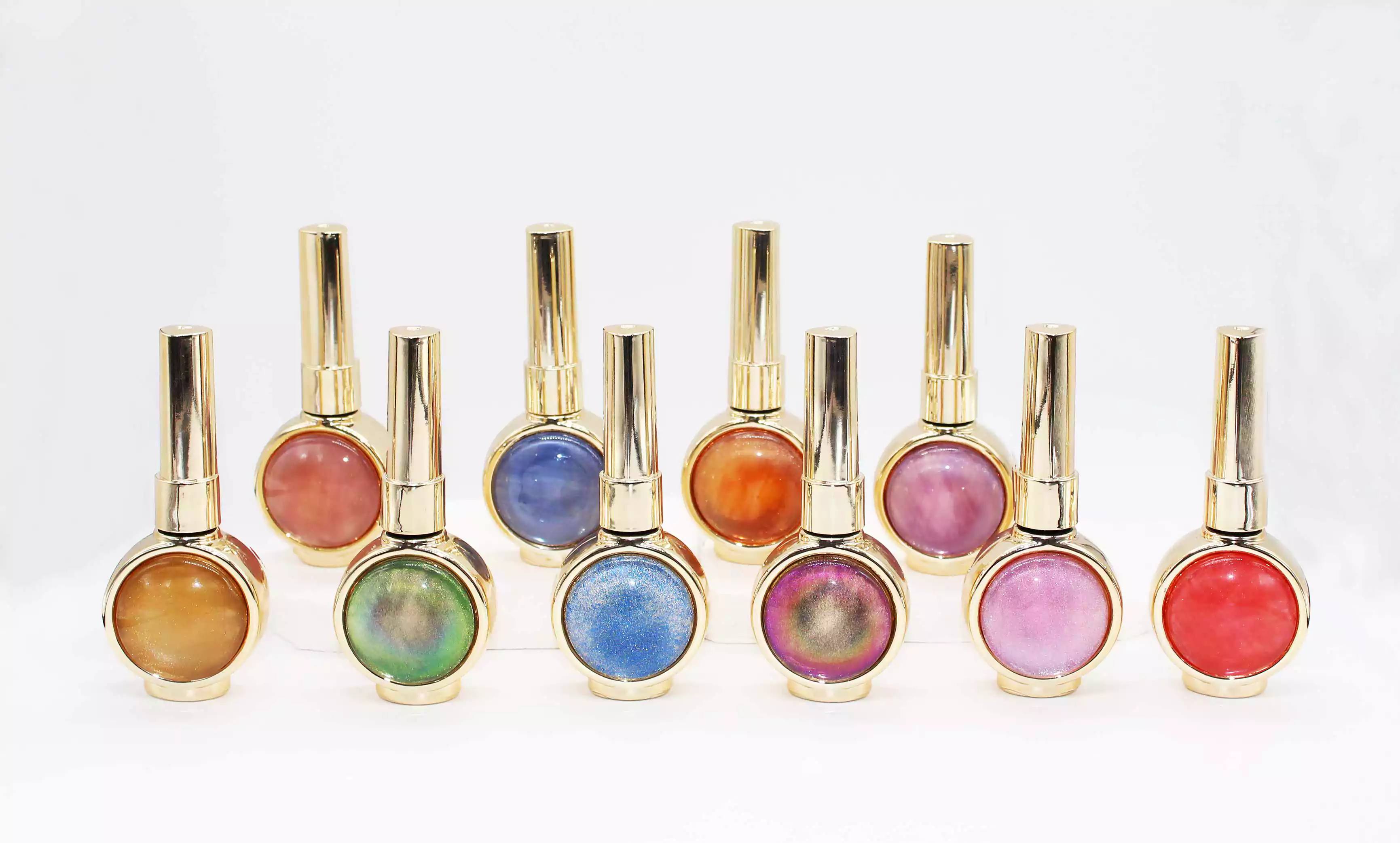Can Gel Polish dry without UV light?
I am Harold, the Brand manager of CHROMÉCLAIR, it is a hema free gel polish brands.
This is a very common question, but the answer is clear:
No. Gel polish cannot truly dry and cure without a UV lamp (or LED lamp).
You can think of it as a “wet” plastic resin that requires specific wavelengths of UV light to trigger a chemical reaction within its internal photoinitiators, transforming it from a liquid into a hard solid.
Here’s a detailed explanation:
1. The drying principles are fundamentally different
Regular Nail Polish: Dries through “evaporation.” Solvents in the polish (like ethyl acetate or butyl acetate) evaporate into the air, leaving pigments and film-forming agents to form a hard coating on the nail. This process requires no special equipment—just air circulation and time.
Gel Nail Polish: Dries through “curing.” It contains photosensitive oligomers and monomers that undergo cross-linking polymerization (Curing) when exposed to specific wavelengths (typically 365nm-405nm UV or LED light). This reaction instantly transforms them from liquid into a hard, cross-linked solid polymer. This process is not evaporation, but a chemical reaction.
2. What happens without a UV lamp?
If you apply gel polish without curing it under a lamp, the following occurs:
Surface never dries: Even after hours of waiting, the nail surface may still feel tacky and sticky (this sticky layer is called the “inhibitor layer,” which persists even after curing and requires removal with alcohol).
Extremely fragile: Even if the top layer feels somewhat dry, the slightest touch will leave fingerprints or scratches, and the entire polish layer will wrinkle, failing to form a smooth, hard surface.
Lack of durability: Since no curing reaction occurs, adhesion is extremely poor, leading to rapid lifting or complete peeling.
Notes on some “alternative methods” (and why they don’t work):
Some people try methods like using a hairdryer, sun exposure, or refrigeration, but these do not work:
Hairdryer: Blowing hot air only accelerates solvent evaporation. However, gel polish curing relies on a photochemical reaction, not solvent evaporation. At best, hot air makes the surface sticky and wrinkled; it cannot harden the interior.
Sunlight: Sunlight does contain UV rays, but its intensity is far too low and its wavelengths are too scattered. Curing gel polish requires high-intensity light at specific wavelengths. Hours under sunlight might cause minimal surface hardening, but the results are extremely poor. It fails to cure deeply, ultimately leaving a messy finish.
LED Lamps/Nail Lamps: This is effective! Modern LED nail lamps are essentially UV LED lamps, emitting light with more concentrated wavelengths, higher efficiency, and faster curing. Thus, “UV lamp” is typically a general term encompassing both traditional fluorescent UV lamps and newer LED UV lamps. You need a lamp that emits UV light with wavelengths between 365nm and 405nm.
If visible-light photoinitiators replace free-radical photoinitiators, can the gel polish produced with this formulation cure without a UV lamp?
Theoretically possible, but practical implementation faces significant challenges. Currently, almost no commercial products exist.
Below, we explain the underlying principles and difficulties in detail:
1. Core Principle: Mechanism of Photoinitiators
Whether traditional UV gels or hypothetical visible-light gels, the curing principle remains identical: Photoinitiators absorb light energy at specific wavelengths, generating reactive species (such as radicals or cations) that trigger polymerization and cross-linking of monomers/UV oligomers, transforming the liquid into a solid.
Traditional Gels: Utilize UV photoinitiators (e.g., photoinitiator TPO, photoinitiator 1173, photoinitiator 184). Their optimal absorption peaks in the UVA range (approx. 365nm-405nm), perfectly matching the emission wavelength of nail lamps. This results in high efficiency, achieving full cure within 30-60 seconds.
Proposed New Gel: Utilizes visible light initiators (e.g., camphorquinone, photoinitiator CQ, commonly used in dental resins; or novel metal complexes, dye-sensitized systems, etc.). Their absorption peaks lie in the blue light range (~450-500 nm) or even longer wavelengths within the visible spectrum.
2. Major Challenges with Visible Light Initiators
Despite sounding promising, using visible light initiators for gel polish presents several nearly insurmountable difficulties:
a. Extremely low curing speed and efficiency (the most critical issue)
UV light (especially 405nm LEDs) possesses higher photon energy than visible light (e.g., 450nm blue light). Higher energy enhances the ability to initiate chemical reactions and improves efficiency.
Visible light initiators typically generate free radicals far less efficiently than high-quality UV initiators.
This means that even when users place their hands under bright sunlight or indoor lighting, it requires an extremely long time (potentially tens of minutes or even hours) to barely cure the surface layer, with deeper layers remaining virtually uncured. This completely negates the core advantage of gel polish: “rapid curing.”
b. Light Source Control and the Risk of “Accidental Curing”
This presents a paradoxical challenge. If a gel polish is so sensitive to visible light that it cures under indoor lighting, it will begin slow polymerization inside the product bottle, resulting in extremely poor stability and a very short shelf life.
Nail technicians would also face significant operational challenges (application, shaping) as the gel would start thickening during brushing, impairing flow and handling. The extended working time of current UV gels (eliminating pre-curing concerns) is precisely one of their key advantages.
c. Light Intensity and Wavelength Issues
The intensity (irradiance) of natural or indoor light is far lower than that of professional nail lamps. Nail lamps deliver concentrated, high-power light at specific wavelengths, ensuring rapid and deep curing.
The visible light spectrum is broad, and different visible light initiators require specific wavelengths for activation. It’s challenging for a single initiator to efficiently utilize all visible light. Natural light, being full-spectrum, disperses energy and operates with lower efficiency.
d. Formulation Complexity and Cost
The entire light-curing industry (including nail care, coatings, and 3D printing) currently builds its resin, monomer, and additive systems around highly efficient UV initiators.
Developing a new visible-light-based system that matches existing products in performance (color, hardness, toughness, adhesion) incurs extremely high R&D costs.
Visible light initiators (especially highly efficient, non-toxic ones) may inherently be more expensive than UV initiators.
e. Potential Safety Concerns
Some highly efficient visible light initiator systems may contain heavy metals (e.g., iodonium salts, metal complexes) or other components posing potential health risks—unacceptable for nail products in direct skin contact.
Real-world analogy: Dental resins
Dental filling resins do extensively use camphorquinone (CQ) as a visible blue-light initiator (peak absorption ~468nm). But note:
They require extremely high-intensity blue LED curing lights (with precisely matched wavelengths) for tens of seconds of exposure.
They absolutely cannot cure under ordinary clinic lighting.
This precisely demonstrates that even with visible light initiators, high-intensity, specific-wavelength professional light sources remain indispensable.
Conclusion
So, returning to your question:
If a visible light photoinitiator were used instead, could the gel polish produced from this raw material cure without a UV lamp?
Theoretically, it could dispense with traditional “UV lamps”, but it would almost certainly require a high-intensity, dedicated lamp customized for its specific wavelength (e.g., blue light) to cure. It cannot reliably achieve fast, complete curing under natural or indoor lighting.
In practice, developing a product that can be safely stored under ambient light yet cure rapidly when needed presents a significant technical paradox and challenge. For the foreseeable future, “specialized light sources” remain an indispensable part of gel polish curing, whether emitting UVA or specific wavelengths of visible blue light.
Therefore, the kind of gel polish you envision—one that dries after “just soaking up some sun or shining a regular desk lamp on it”—currently exists only in science fiction.
CHROMÉCLAIR offers Base coats, Top coats, solid color gel polish without HEMA, and hema free cat eye gel polish.
Their website also features nail art tutorials, such as:


